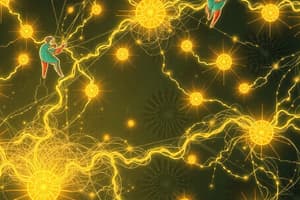Podcast
Questions and Answers
According to Ohm's Law, if the voltage in a circuit is doubled while resistance remains constant, what happens to the current?
According to Ohm's Law, if the voltage in a circuit is doubled while resistance remains constant, what happens to the current?
- It quadruples
- It doubles (correct)
- It remains the same
- It halves
Kirchhoff's Current Law states that the total current leaving a junction is less than the total current entering the junction.
Kirchhoff's Current Law states that the total current leaving a junction is less than the total current entering the junction.
False (B)
What does the formula V = I × R represent?
What does the formula V = I × R represent?
Ohm's Law
In a closed circuit loop, the sum of the electrical potential differences equals _____ according to Kirchhoff's Voltage Law.
In a closed circuit loop, the sum of the electrical potential differences equals _____ according to Kirchhoff's Voltage Law.
Match the following components with their corresponding laws:
Match the following components with their corresponding laws:
Flashcards are hidden until you start studying
Study Notes
Electric Current
- Definition: Electric current is the flow of electric charge, typically measured in amperes (A).
Ohm's Law
- Formula: V = I × R
- V = Voltage (volts)
- I = Current (amperes)
- R = Resistance (ohms)
- Key Concepts:
- Direct relationship between voltage and current (higher voltage, higher current).
- Inverse relationship between current and resistance (higher resistance, lower current).
- Applications: Used to calculate the behavior of electrical circuits and components.
Kirchhoff's Laws
-
Kirchhoff's Current Law (KCL):
- States that the total current entering a junction equals the total current leaving the junction.
- Based on the conservation of charge.
- Mathematically: ΣI_in = ΣI_out
-
Kirchhoff's Voltage Law (KVL):
- States that the sum of the electrical potential differences (voltage) around any closed circuit loop is equal to zero.
- Based on the conservation of energy.
- Mathematically: ΣV = 0 for a closed loop.
- Applications: Essential for analyzing complex electrical circuits, helping to determine unknown currents and voltages.
Electric Current
- Electric current refers to the flow of electric charge, typically measured in amperes (A).
Ohm's Law
- Ohm's Law is represented by the formula: V = I × R.
- V symbolizes voltage measured in volts.
- I denotes current measured in amperes.
- R represents resistance measured in ohms.
- There is a direct relationship between voltage and current: as voltage increases, current increases.
- There is an inverse relationship between current and resistance: as resistance increases, current decreases.
- Ohm's Law is fundamental for calculating the behavior of electrical circuits and components.
Kirchhoff's Laws
-
Kirchhoff's Current Law (KCL) states that the total current entering a junction is equal to the total current leaving that junction.
- This principle is based on the conservation of charge, ensuring all electric charge is accounted for.
- Mathematically expressed as: ΣI_in = ΣI_out.
-
Kirchhoff's Voltage Law (KVL) asserts that the sum of all electrical potential differences (voltages) around a closed circuit loop equals zero.
- This is founded on the conservation of energy principle.
- Mathematically expressed as: ΣV = 0 for any closed loop.
-
Kirchhoff's Laws are essential for analyzing complex electrical circuits and calculating unknown currents and voltages.
Studying That Suits You
Use AI to generate personalized quizzes and flashcards to suit your learning preferences.




